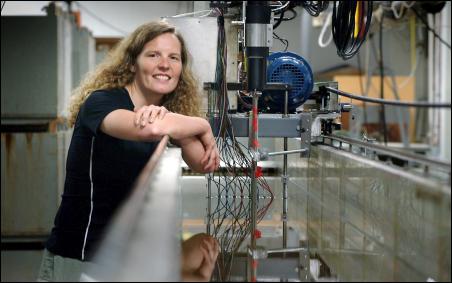Study To Provide Answers For Flood Management
A University of Auckland PhD study on sand wave formations could ultimately lead to better flood management and a better understanding of river environments.

Heide Friedrich, from Auckland
University's Faculty of Engineering.
Heide Friedrich, from the Faculty of Engineering, is investigating how sand waves form and grow and what effect they have on river beds. Her project is partially supported from a Marsden Fund grant.
When water flows over a bed of sand particles, the particles move thereby creating a regular pattern of sand waves in the bed. The movement of water results in the creation of ripples, dunes and sandbars.
“Previous research, some dating back to the last century, does not provide a consistent argument on how sand waves actually form. What I am looking at is the basics of what causes the waves to form as they do and the resulting effects on sand beds,” says Heide.
Sand forms play an important role in the daily lives of many coastal communities.
“A better understanding of how sand waves appear will help anticipate changes in sand forms and plan for them in advance. This will minimise problems such as floods, sedimentation of estuaries and erosion around submerged structures.
“Foundations of buildings and other structures can become exposed over time as sand forms change. This can have serious consequences for the infrastructure of a region, for example bridges might collapse,” says Heide.
Newly available analysing methods allow researchers to critically examine the complex interaction between the erodible bed and the flow which works on it.
Heide, who is based at the Department of Civil and Environmental Engineering’s Hydraulic Engineering Laboratory, is simulating wave movements in a glass-sided open channel flume, 12 metres in length, 0.44m wide and 0.38m in depth. The sediment bed in the flume has been simulated using sand grains.
A series of experimental runs focusing on measuring velocity, bed elevation, water depth, channel slope, flow rate and grain motion have been carried out over the past year.
The water flow in the flume can be changed to simulate real life situations. On the rails of the flume, a carriage carries a conventional depth sounding probe, high frequency acoustic sensors and several Acoustic Doppler Velocimeters which record the profiles of the developing bed and the flow velocity at different water levels. The acoustic sensors were provided by NIWA, who are partners in the Marsden-funded project.
As part of her research, Heide can simulate a flood situation in the flume to record changes in the river environment on various levels.
“During a flood, a larger volume of water travels over the same channel. This affects the size and movement of the water field, which then affects the sand forms.
“If we can predict how sand waves form during floods and how that affects the sand bed, we should be able to plan for these changes and reduce the impact of floods on people living near rivers.”
Heide is using sophisticated measurement equipment which helps her record three-dimensional results.
“A lot of studies in the past have relied on two-dimensional data but with a 3D view you can get more information which is great for expanding the body of knowledge in this area,” she says.
The data collected from the study could be applied to various river environments around the world.
For many years, researchers have tried to predict how the downstream environment in Asia’s mighty Mekong River changes. And while Heide doesn’t claim to have all the answers, she hopes her findings will shed some light on how and why bedforms move as they do.
“The Mekong River has huge sand banks which change form rapidly and sometimes this means that people can’t use the river for transportation purposes. From my data, we will be able to have a better understanding of the behaviour of sand forms and hopefully this will be of use in the case of the Mekong and other similar situations.”
A graduate of the Technical University of Berlin, Heide has studied and worked in Europe, Australia and Asia. A water sport enthusiast, she is a passionate scuba diver and sailor and says it was her love of water sports that brought her to New Zealand and helped her decide her PhD topic.
“My research is inherently about the water, and if you don’t look at the lab equipment, it’s a bit like sitting on the beach.”


 NZFC: Apply For The New Zealand Film Commission’s He Kauahi Catalyst
NZFC: Apply For The New Zealand Film Commission’s He Kauahi Catalyst  Organ Donation NZ: Organ And Tissue Donation Helped Save And Improve The Lives Of Hundreds Of People In 2024
Organ Donation NZ: Organ And Tissue Donation Helped Save And Improve The Lives Of Hundreds Of People In 2024 Taupo District Council: Punarua Exhibition Arrives At Taupō Museum
Taupo District Council: Punarua Exhibition Arrives At Taupō Museum Office of Early Childhood Education: Teachers Are Paying The Price For Lack Of ECE Funding In The Budget
Office of Early Childhood Education: Teachers Are Paying The Price For Lack Of ECE Funding In The Budget Science Media Centre: Teen Dies After Controversial Tackle Game – Expert Reaction
Science Media Centre: Teen Dies After Controversial Tackle Game – Expert Reaction Howard Davis: The Amici Ensemble Provide A Master Class In Françaix, Fauré, & Brahms
Howard Davis: The Amici Ensemble Provide A Master Class In Françaix, Fauré, & Brahms